charging RENAULT TWINGO RS 2009 2.G Electrical Equipment - Petrol Injection User Guide
[x] Cancel search | Manufacturer: RENAULT, Model Year: 2009, Model line: TWINGO RS, Model: RENAULT TWINGO RS 2009 2.GPages: 348
Page 53 of 348
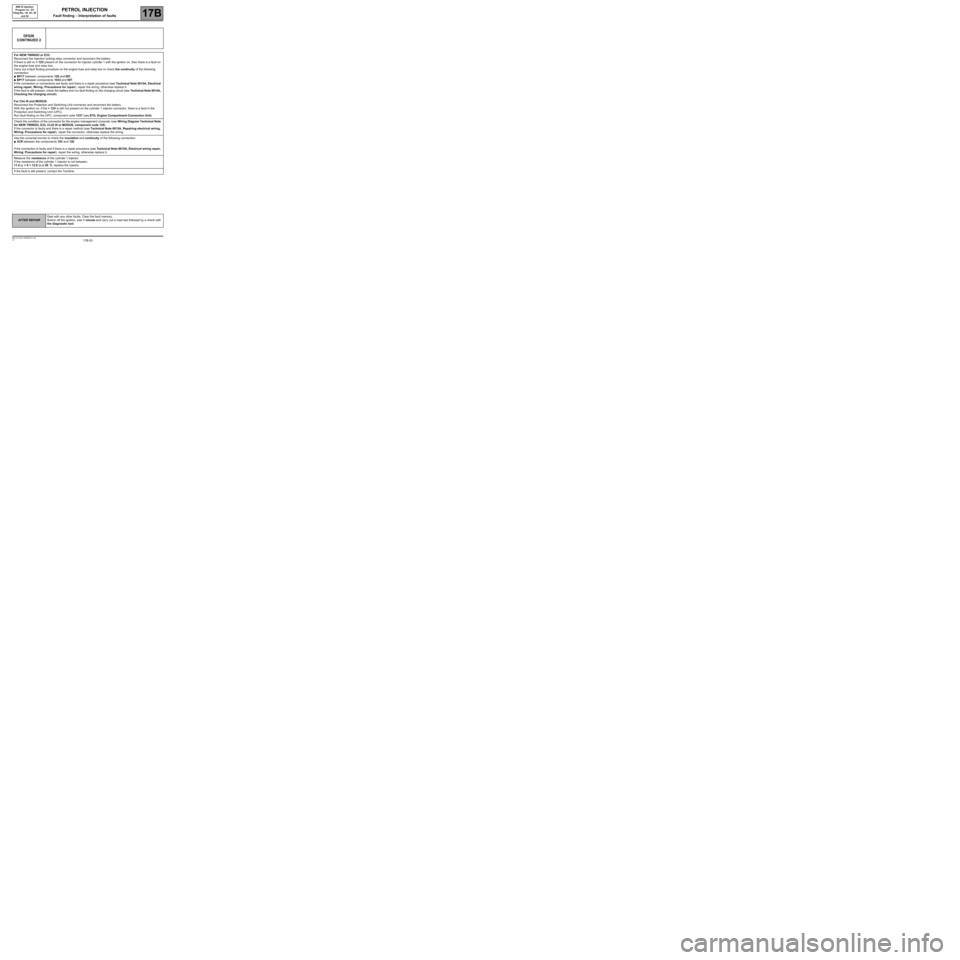
17B-53V7 MR-413-X44-17B000$131.mif
PETROL INJECTION
Fault finding – Interpretation of faults17B
SIM 32 Injection
Program no.: D3
Vdiag No.: 44, 4C, 50
and 54
DF026
CONTINUED 2
For NEW TWINGO or E33:
Reconnect the injection locking relay connector and reconnect the battery.
If there is still no + 12V present on the connector for injector cylinder 1 with the ignition on, then there is a fault on
the engine fuse and relay box.
Carry out a fault finding procedure on the engine fuse and relay box to check the continuity of the following
connection:
●BP17 between components 120 and 597,
●BP17 between components 1033 and 597.
If the connection or connections are faulty and there is a repair procedure (see Technical Note 6015A, Electrical
wiring repair, Wiring: Precautions for repair), repair the wiring, otherwise replace it.
If the fault is still present, check the battery and run fault finding on the charging circuit (see Technical Note 6014A,
Checking the charging circuit).
For Clio III and MODUS:
Reconnect the Protection and Switching Unit connector and reconnect the battery.
With the ignition on, if the + 12V is still not present on the cylinder 1 injector connector, there is a fault in the
Protection and Switching Unit (UPC).
Run fault finding on the UPC, component code 1337 (see 87G, Engine Compartment Connection Unit).
Check the condition of the connector for the engine management computer (see Wiring Diagram Technical Note
for NEW TWINGO, E33, CLIO III or MODUS, component code 120).
If the connector is faulty and there is a repair method (see Technical Note 6015A, Repairing electrical wiring,
Wiring: Precautions for repair), repair the connector, otherwise replace the wiring.
Use the universal bornier to check the insulation and continuity of the following connection:
●3CR between the components 193 and 120.
If the connection is faulty and if there is a repair procedure (see Technical Note 6015A, Electrical wiring repair,
Wiring: Precautions for repair), repair the wiring, otherwise replace it.
Measure the resistance of the cylinder 1 injector:
If the resistance of the cylinder 1 injector is not between:
11.4
Ω < X < 12.6 Ω at 20 ˚C, replace the injector.
If the fault is still present, contact the Techline.
AFTER REPAIRDeal with any other faults. Clear the fault memory.
Switch off the ignition, wait 1 minute and carry out a road test followed by a check with
the diagnostic tool.
Page 56 of 348
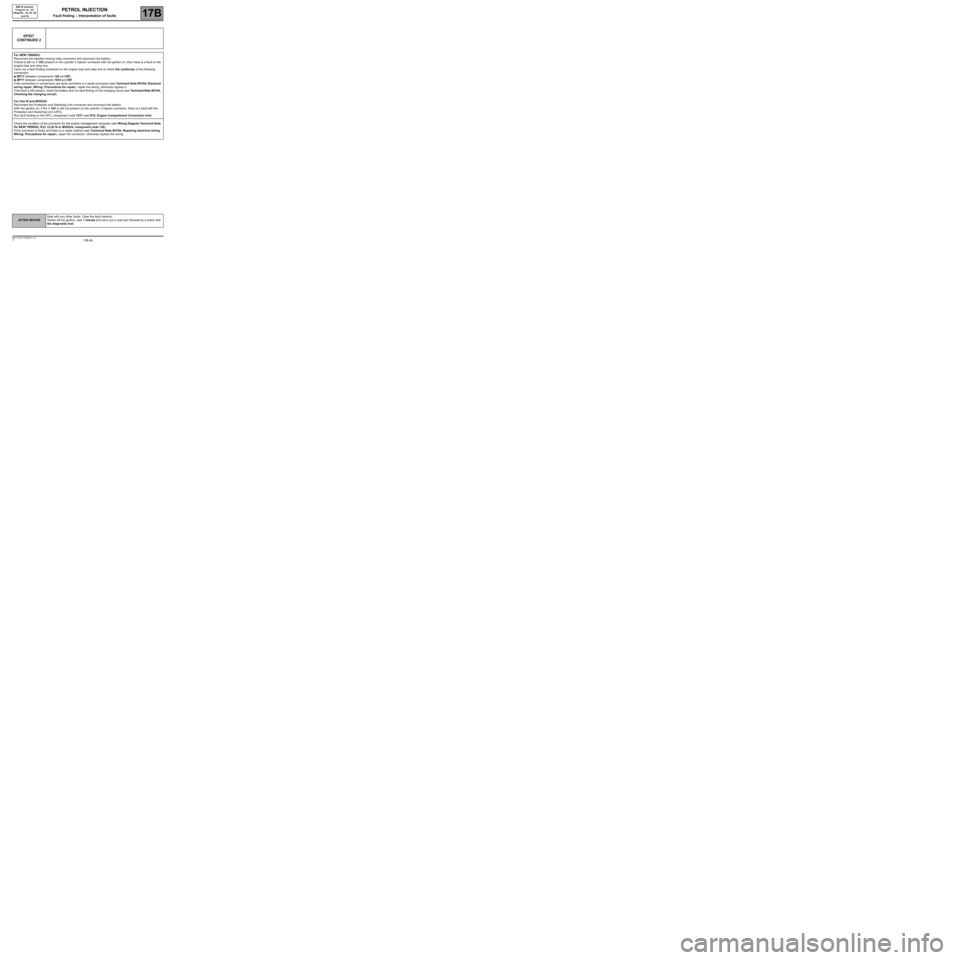
17B-56V7 MR-413-X44-17B000$131.mif
PETROL INJECTION
Fault finding – Interpretation of faults17B
SIM 32 Injection
Program no.: D3
Vdiag No.: 44, 4C, 50
and 54
DF027
CONTINUED 2
For NEW TWINGO:
Reconnect the injection locking relay connector and reconnect the battery.
If there is still no + 12V present on the cylinder 2 injector connector with the ignition on, then there is a fault on the
engine fuse and relay box.
Carry out a fault finding procedure on the engine fuse and relay box to check the continuity of the following
connection:
●BP17 between components 120 and 597,
●BP17 between components 1033 and 597.
If the connection or connections are faulty and there is a repair procedure (see Technical Note 6015A, Electrical
wiring repair, Wiring: Precautions for repair), repair the wiring, otherwise replace it.
If the fault is still present, check the battery and run fault finding on the charging circuit (see Technical Note 6014A,
Checking the charging circuit).
For Clio III and MODUS:
Reconnect the Protection and Switching Unit connector and reconnect the battery.
With the ignition on, if the + 12V is still not present on the cylinder 2 injector connector, there is a fault with the
Protection and Switching Unit (UPC).
Run fault finding on the UPC, component code 1337 (see 87G, Engine Compartment Connection Unit).
Check the condition of the connector for the engine management computer (see Wiring Diagram Technical Note
for NEW TWINGO, E33, CLIO III or MODUS, component code 120).
If the connector is faulty and there is a repair method (see Technical Note 6015A, Repairing electrical wiring,
Wiring: Precautions for repair), repair the connector, otherwise replace the wiring.
AFTER REPAIRDeal with any other faults. Clear the fault memory.
Switch off the ignition, wait 1 minute and carry out a road test followed by a check with
the diagnostic tool.
Page 60 of 348
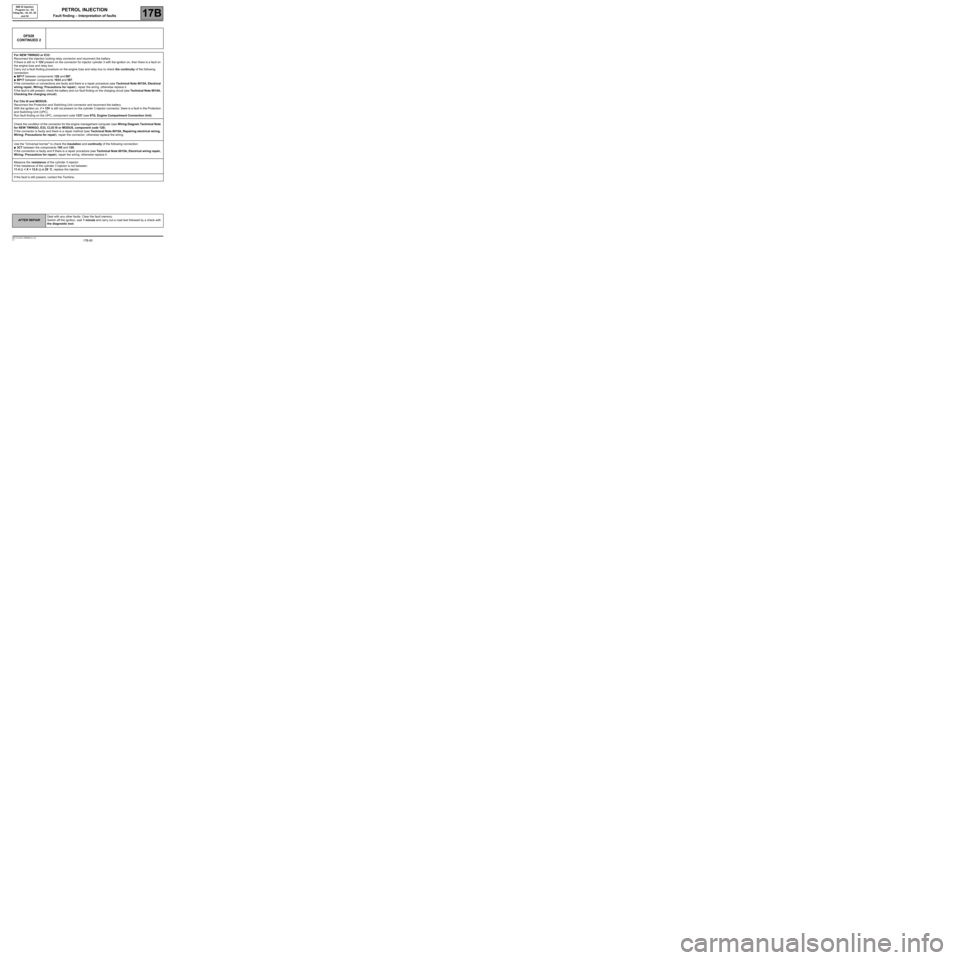
17B-60V7 MR-413-X44-17B000$131.mif
PETROL INJECTION
Fault finding – Interpretation of faults17B
SIM 32 Injection
Program no.: D3
Vdiag No.: 44, 4C, 50
and 54
DF028
CONTINUED 2
For NEW TWINGO or E33:
Reconnect the injection locking relay connector and reconnect the battery.
If there is still no + 12V present on the connector for injector cylinder 3 with the ignition on, then there is a fault on
the engine fuse and relay box.
Carry out a fault finding procedure on the engine fuse and relay box to check the continuity of the following
connection:
●BP17 between components 120 and 597,
●BP17 between components 1033 and 597.
If the connection or connections are faulty and there is a repair procedure (see Technical Note 6015A, Electrical
wiring repair, Wiring: Precautions for repair), repair the wiring, otherwise replace it.
If the fault is still present, check the battery and run fault finding on the charging circuit (see Technical Note 6014A,
Checking the charging circuit).
For Clio III and MODUS:
Reconnect the Protection and Switching Unit connector and reconnect the battery.
With the ignition on, if + 12V is still not present on the cylinder 3 injector connector, there is a fault in the Protection
and Switching Unit (UPC).
Run fault finding on the UPC, component code 1337 (see 87G, Engine Compartment Connection Unit).
Check the condition of the connector for the engine management computer (see Wiring Diagram Technical Note
for NEW TWINGO, E33, CLIO III or MODUS, component code 120).
If the connector is faulty and there is a repair method (see Technical Note 6015A, Repairing electrical wiring,
Wiring: Precautions for repair), repair the connector, otherwise replace the wiring.
Use the "Universal bornier" to check the insulation and continuity of the following connection:
●3CT between the components 195 and 120.
If the connection is faulty and if there is a repair procedure (see Technical Note 6015A, Electrical wiring repair,
Wiring: Precautions for repair), repair the wiring, otherwise replace it.
Measure the resistance of the cylinder 3 injector:
If the resistance of the cylinder 3 injector is not between:
11.4
Ω < X < 12.6 Ω at 20 ˚C, replace the injector.
If the fault is still present, contact the Techline.
AFTER REPAIRDeal with any other faults. Clear the fault memory.
Switch off the ignition, wait 1 minute and carry out a road test followed by a check with
the diagnostic tool.
Page 63 of 348
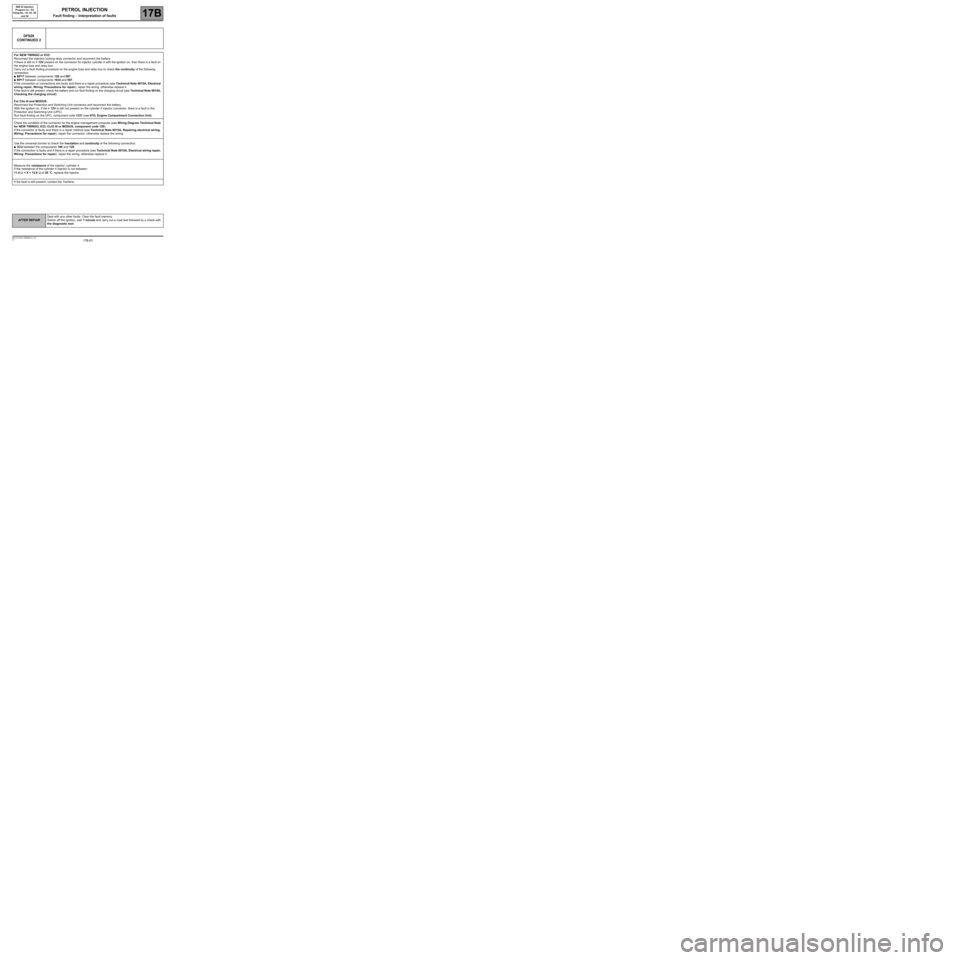
17B-63V7 MR-413-X44-17B000$131.mif
PETROL INJECTION
Fault finding – Interpretation of faults17B
SIM 32 Injection
Program no.: D3
Vdiag No.: 44, 4C, 50
and 54
DF029
CONTINUED 2
For NEW TWINGO or E33:
Reconnect the injection locking relay connector and reconnect the battery.
If there is still no + 12V present on the connector for injector cylinder 4 with the ignition on, then there is a fault on
the engine fuse and relay box.
Carry out a fault finding procedure on the engine fuse and relay box to check the continuity of the following
connection:
●BP17 between components 120 and 597,
●BP17 between components 1033 and 597.
If the connection or connections are faulty and there is a repair procedure (see Technical Note 6015A, Electrical
wiring repair, Wiring: Precautions for repair), repair the wiring, otherwise replace it.
If the fault is still present, check the battery and run fault finding on the charging circuit (see Technical Note 6014A,
Checking the charging circuit).
For Clio III and MODUS:
Reconnect the Protection and Switching Unit connector and reconnect the battery.
With the ignition on, if the + 12V is still not present on the cylinder 4 injector connector, there is a fault in the
Protection and Switching Unit (UPC).
Run fault finding on the UPC, component code 1337 (see 87G, Engine Compartment Connection Unit).
Check the condition of the connector for the engine management computer (see Wiring Diagram Technical Note
for NEW TWINGO, E33, CLIO III or MODUS, component code 120).
If the connector is faulty and there is a repair method (see Technical Note 6015A, Repairing electrical wiring,
Wiring: Precautions for repair), repair the connector, otherwise replace the wiring.
Use the universal bornier to check the insulation and continuity of the following connection:
●3CU between the components 196 and 120.
If the connection is faulty and if there is a repair procedure (see Technical Note 6015A, Electrical wiring repair,
Wiring: Precautions for repair), repair the wiring, otherwise replace it.
Measure the resistance of the injector, cylinder 4.
If the resistance of the cylinder 4 injector is not between:
11.4
Ω < X < 12.6 Ω at 20 ˚C, replace the injector.
If the fault is still present, contact the Techline.
AFTER REPAIRDeal with any other faults. Clear the fault memory.
Switch off the ignition, wait 1 minute and carry out a road test followed by a check with
the diagnostic tool.
Page 65 of 348
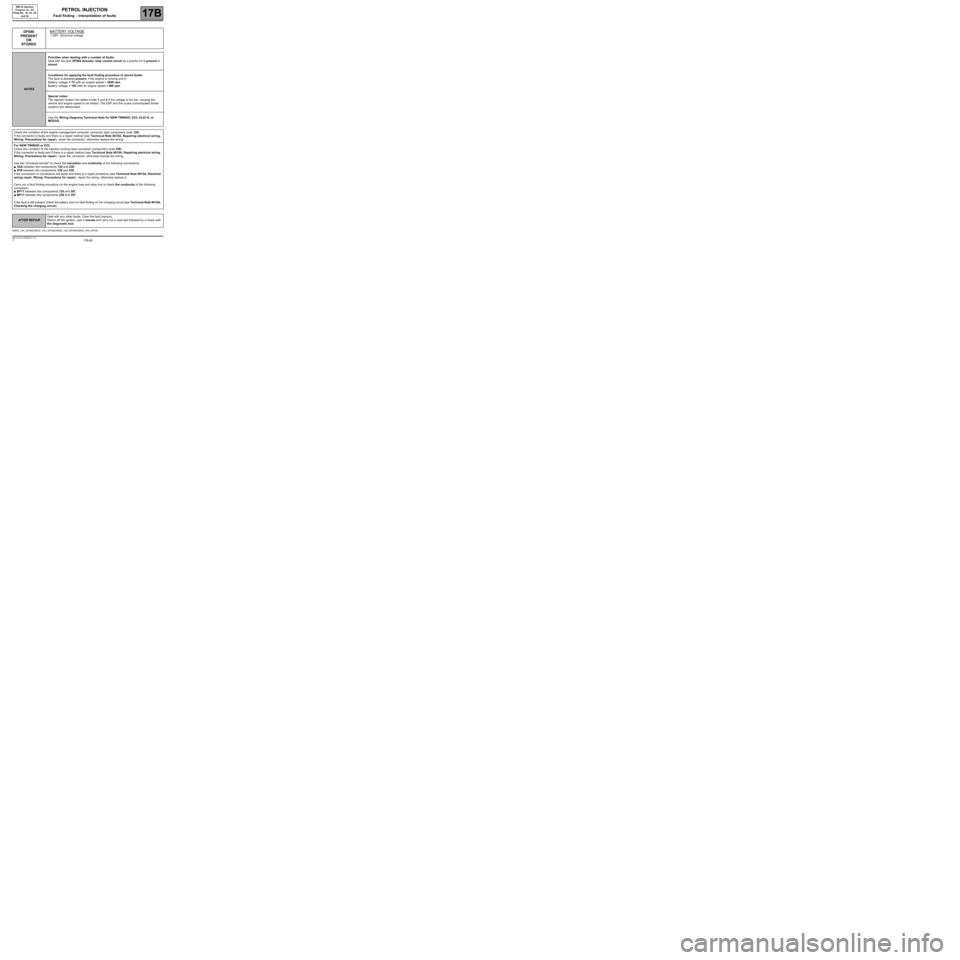
17B-65V7 MR-413-X44-17B000$131.mif
PETROL INJECTION
Fault finding – Interpretation of faults17B
SIM 32 Injection
Program no.: D3
Vdiag No.: 44, 4C, 50
and 54
DF046
PRESENT
OR
STOREDBATTERY VOLTAGE
1.DEF: Abnormal voltage
NOTESPriorities when dealing with a number of faults:
Deal with the fault DF084 Actuator relay control circuit as a priority if it is present or
stored.
Conditions for applying the fault finding procedure to stored faults:
The fault is declared present, if the engine is running and if:
Battery voltage < 7V with an engine speed > 2000 rpm,
Battery voltage > 16V with an engine speed < 480 rpm.
Special notes:
The injection enters into defect mode 1 and 2 if the voltage is too low, causing the
vehicle and engine speed to be limited. The ESP and the cruise control/speed limiter
systems are deactivated.
Use the Wiring Diagrams Technical Note for NEW TWINGO, E33, CLIO III, or
MODUS.
Check the condition of the engine management computer connector (see component code 120).
If the connector is faulty and there is a repair method (see Technical Note 6015A, Repairing electrical wiring,
Wiring: Precautions for repair), repair the connector, otherwise replace the wiring.
For NEW TWINGO or E33:
Check the condition of the injection locking relay connector (component code 238).
If the connector is faulty and if there is a repair method (see Technical Note 6015A, Repairing electrical wiring,
Wiring: Precautions for repair), repair the connector, otherwise change the wiring.
Use the "Universal bornier" to check the insulation and continuity of the following connections:
●3AA between the components 120 and 238,
●3FB between the components 120 and 238.
If the connection or connections are faulty and there is a repair procedure (see Technical Note 6015A, Electrical
wiring repair, Wiring: Precautions for repair), repair the wiring, otherwise replace it.
Carry out a fault finding procedure on the engine fuse and relay box to check the continuity of the following
connection:
●BP17 between the components 120 and 397,
●BP17 between the components 238 and 397.
If the fault is still present, check the battery and run fault finding on the charging circuit (see Technical Note 6014A,
Checking the charging circuit).
SIM32_V44_DF046/SIM32_V4C_DF046/SIM32_V50_DF046/SIM32_V54_DF046
AFTER REPAIRDeal with any other faults. Clear the fault memory.
Switch off the ignition, wait 1 minute and carry out a road test followed by a check with
the diagnostic tool.
Page 66 of 348
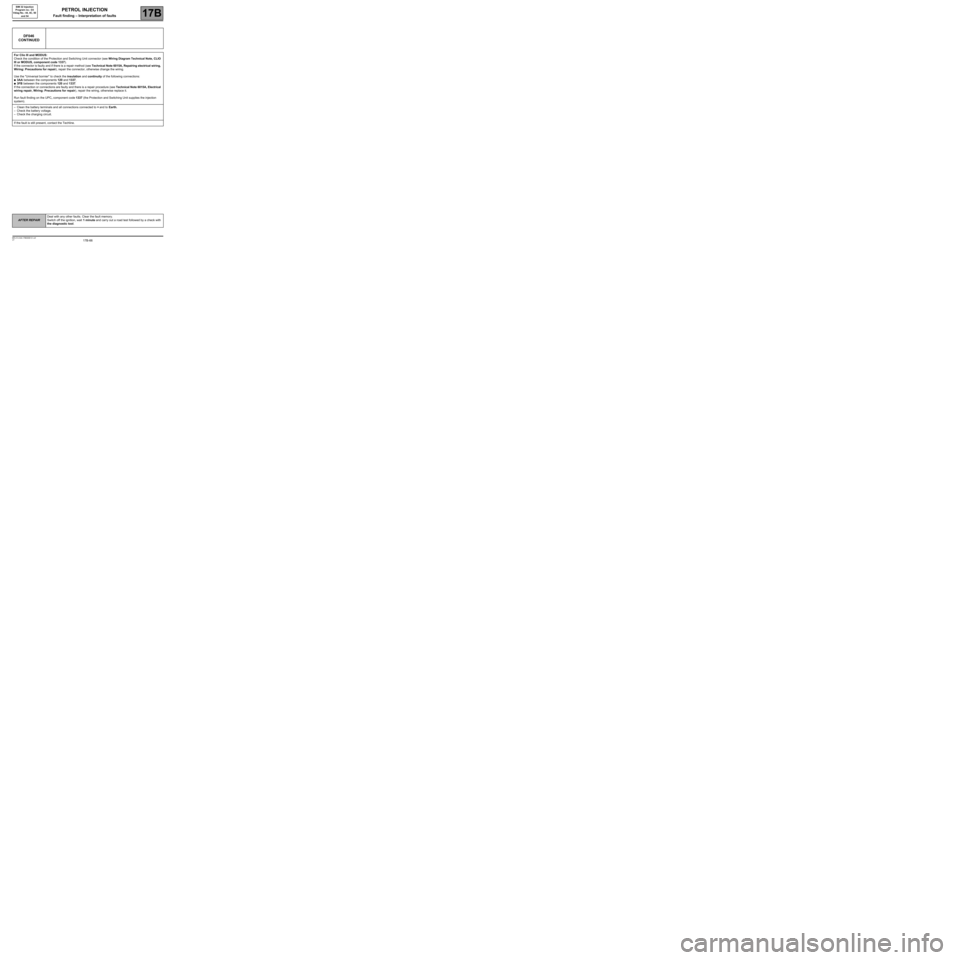
17B-66V7 MR-413-X44-17B000$131.mif
PETROL INJECTION
Fault finding – Interpretation of faults17B
SIM 32 Injection
Program no.: D3
Vdiag No.: 44, 4C, 50
and 54
DF046
CONTINUED
For Clio III and MODUS:
Check the condition of the Protection and Switching Unit connector (see Wiring Diagram Technical Note, CLIO
III or MODUS, component code 1337).
If the connector is faulty and if there is a repair method (see Technical Note 6015A, Repairing electrical wiring,
Wiring: Precautions for repair), repair the connector, otherwise change the wiring.
Use the "Universal bornier" to check the insulation and continuity of the following connections:
●3AA between the components 120 and 1337,
●3FB between the components 120 and 1337.
If the connection or connections are faulty and there is a repair procedure (see Technical Note 6015A, Electrical
wiring repair, Wiring: Precautions for repair), repair the wiring, otherwise replace it.
Run fault finding on the UPC, component code 1337 (the Protection and Switching Unit supplies the injection
system).
–Clean the battery terminals and all connections connected to + and to Earth.
–Check the battery voltage.
–Check the charging circuit.
If the fault is still present, contact the Techline.
AFTER REPAIRDeal with any other faults. Clear the fault memory.
Switch off the ignition, wait 1 minute and carry out a road test followed by a check with
the diagnostic tool.
Page 67 of 348
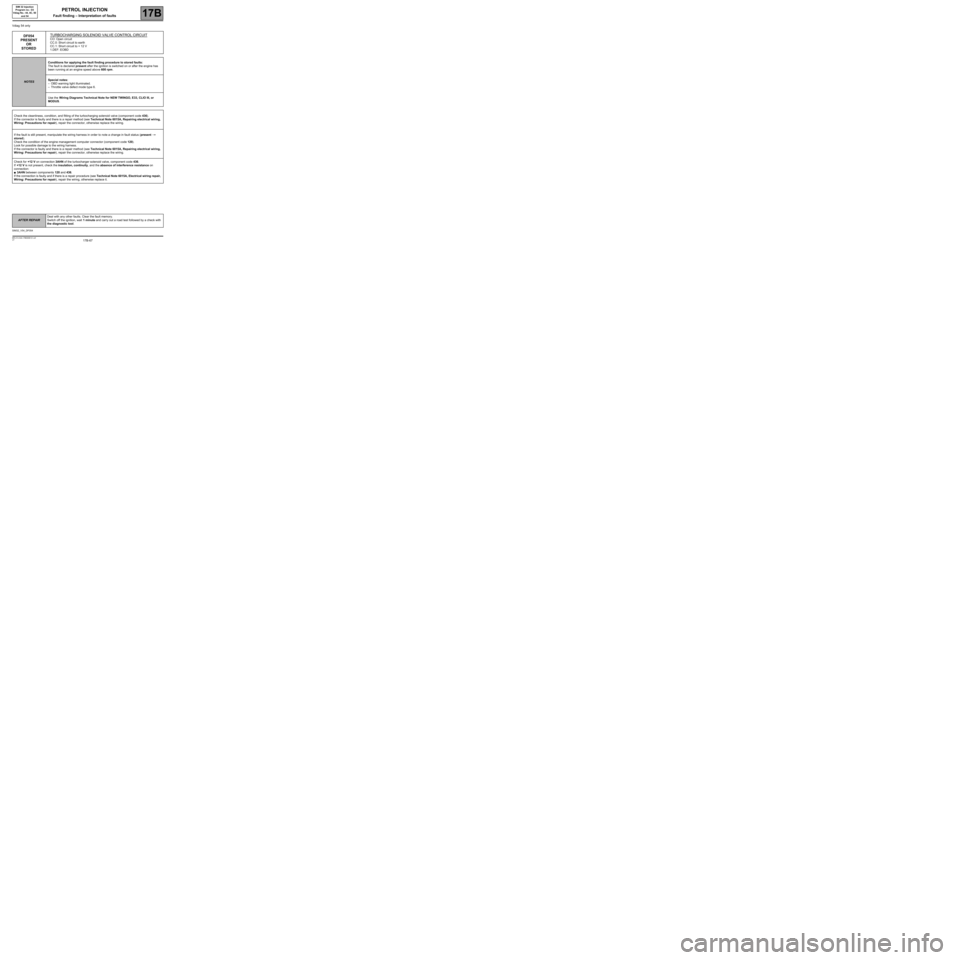
17B-67V7 MR-413-X44-17B000$131.mif
PETROL INJECTION
Fault finding – Interpretation of faults17B
SIM 32 Injection
Program no.: D3
Vdiag No.: 44, 4C, 50
and 54
Vdiag 54 only
DF054
PRESENT
OR
STOREDTURBOCHARGING SOLENOID VALVE CONTROL CIRCUITCO: Open circuit
CC.0: Short circuit to earth
CC.1: Short circuit to + 12 V
1.DEF: EOBD
NOTESConditions for applying the fault finding procedure to stored faults:
The fault is declared present after the ignition is switched on or after the engine has
been running at an engine speed above 600 rpm.
Special notes:
–OBD warning light illuminated.
–Throttle valve defect mode type 6.
Use the Wiring Diagrams Technical Note for NEW TWINGO, E33, CLIO III, or
MODUS.
Check the cleanliness, condition, and fitting of the turbocharging solenoid valve (component code 436).
If the connector is faulty and there is a repair method (see Technical Note 6015A, Repairing electrical wiring,
Wiring: Precautions for repair), repair the connector, otherwise replace the wiring.
If the fault is still present, manipulate the wiring harness in order to note a change in fault status (present
→
stored).
Check the condition of the engine management computer connector (component code 120).
Look for possible damage to the wiring harness.
If the connector is faulty and there is a repair method (see Technical Note 6015A, Repairing electrical wiring,
Wiring: Precautions for repair), repair the connector, otherwise replace the wiring.
Check for +12 V on connection 3AHN of the turbocharger solenoid valve, component code 436.
If +12 V is not present, check the insulation, continuity, and the absence of interference resistance on
connection:
●3AHN between components 120 and 436.
If the connection is faulty and if there is a repair procedure (see Technical Note 6015A, Electrical wiring repair,
Wiring: Precautions for repair), repair the wiring, otherwise replace it.
SIM32_V54_DF054
AFTER REPAIRDeal with any other faults. Clear the fault memory.
Switch off the ignition, wait 1 minute and carry out a road test followed by a check with
the diagnostic tool.
Page 68 of 348
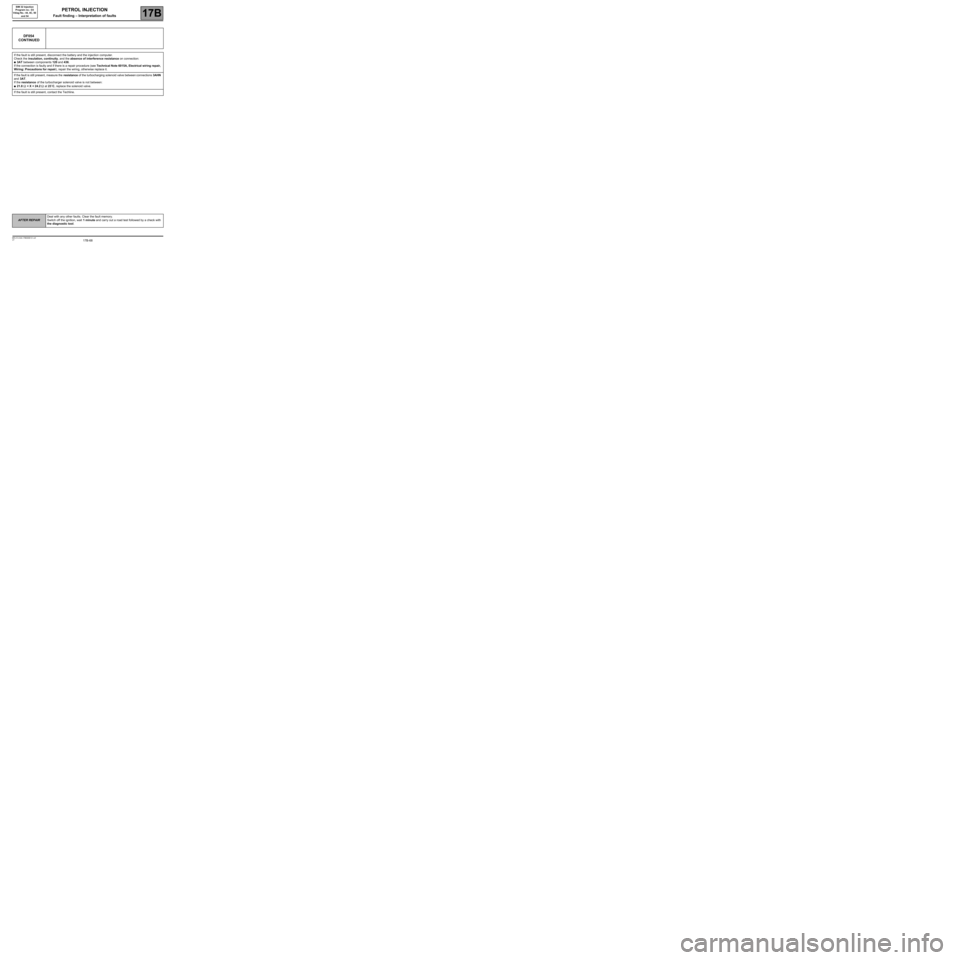
17B-68V7 MR-413-X44-17B000$131.mif
PETROL INJECTION
Fault finding – Interpretation of faults17B
SIM 32 Injection
Program no.: D3
Vdiag No.: 44, 4C, 50
and 54
DF054
CONTINUED
If the fault is still present, disconnect the battery and the injection computer.
Check the insulation, continuity, and the absence of interference resistance on connection:
●3AT between components 120 and 436.
If the connection is faulty and if there is a repair procedure (see Technical Note 6015A, Electrical wiring repair,
Wiring: Precautions for repair), repair the wiring, otherwise replace it.
If the fault is still present, measure the resistance of the turbocharging solenoid valve between connections 3AHN
and 3AT.
If the resistance of the turbocharger solenoid valve is not between:
●21.8 Ω < X < 24.2 Ω at 23˚C, replace the solenoid valve.
If the fault is still present, contact the Techline.
AFTER REPAIRDeal with any other faults. Clear the fault memory.
Switch off the ignition, wait 1 minute and carry out a road test followed by a check with
the diagnostic tool.
Page 86 of 348
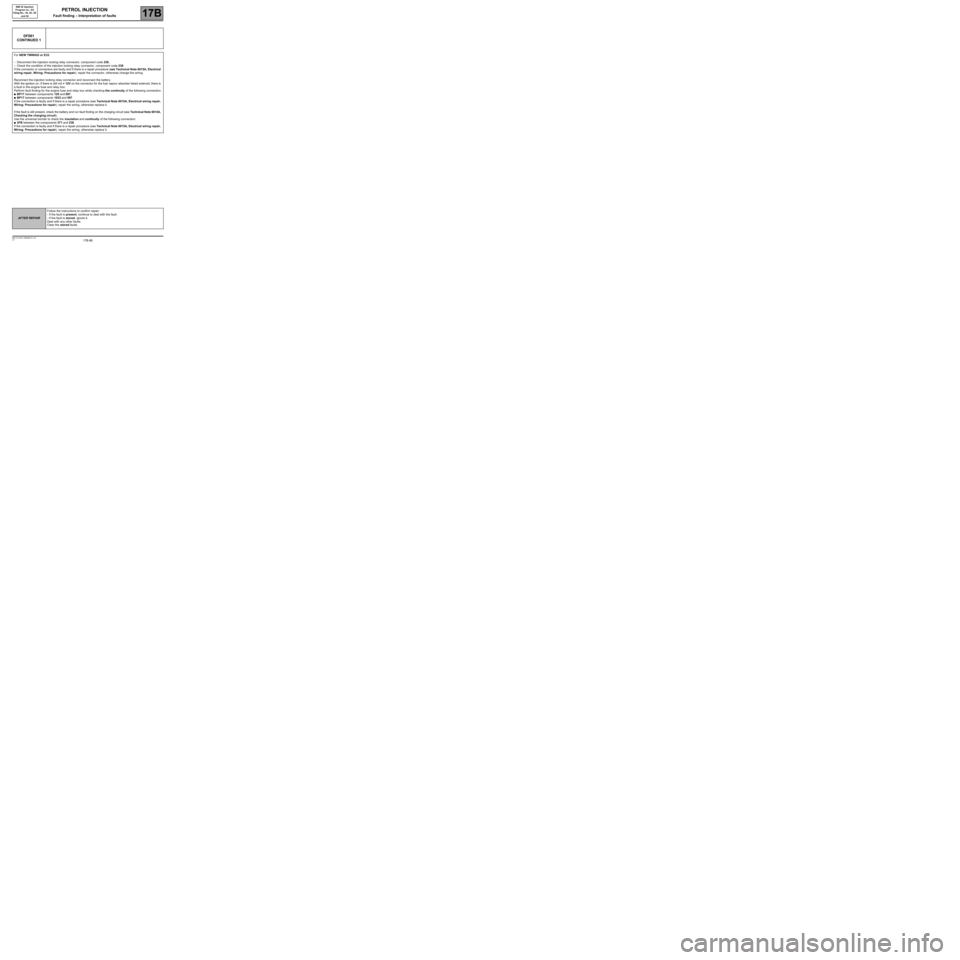
17B-86V7 MR-413-X44-17B000$131.mif
PETROL INJECTION
Fault finding – Interpretation of faults17B
SIM 32 Injection
Program no.: D3
Vdiag No.: 44, 4C, 50
and 54
DF081
CONTINUED 1
For NEW TWINGO or E33:
–Disconnect the injection locking relay connector, component code 238,
–Check the condition of the injection locking relay connector, component code 238.
If the connector or connectors are faulty and if there is a repair procedure (see Technical Note 6015A, Electrical
wiring repair, Wiring: Precautions for repair), repair the connector, otherwise change the wiring.
Reconnect the injection locking relay connector and reconnect the battery.
With the ignition on, if there is still not + 12V on the connector for the fuel vapour absorber bleed solenoid, there is
a fault in the engine fuse and relay box.
Perform fault finding for the engine fuse and relay box while checking the continuity of the following connection:
●BP17 between components 120 and 597,
●BP17 between components 1033 and 597.
If the connection is faulty and if there is a repair procedure (see Technical Note 6015A, Electrical wiring repair,
Wiring: Precautions for repair), repair the wiring, otherwise replace it.
If the fault is still present, check the battery and run fault finding on the charging circuit (see Technical Note 6014A,
Checking the charging circuit).
Use the universal bornier to check the insulation and continuity of the following connection:
●3FB between the components 371 and 238.
If the connection is faulty and if there is a repair procedure (see Technical Note 6015A, Electrical wiring repair,
Wiring: Precautions for repair), repair the wiring, otherwise replace it.
AFTER REPAIRFollow the instructions to confirm repair:
- If the fault is present, continue to deal with the fault.
- If the fault is stored, ignore it.
Deal with any other faults.
Clear the stored faults.
Page 90 of 348
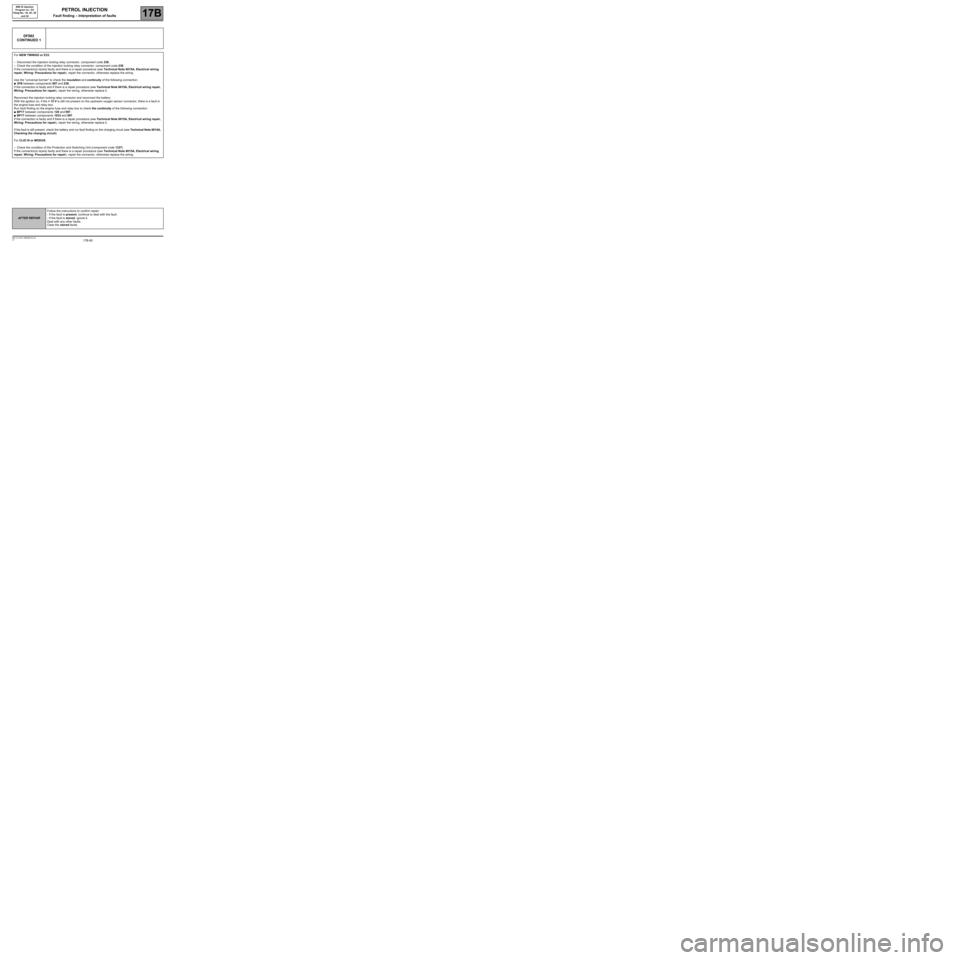
17B-90V7 MR-413-X44-17B000$132.mif
PETROL INJECTION
Fault finding – Interpretation of faults17B
SIM 32 Injection
Program no.: D3
Vdiag No.: 44, 4C, 50
and 54
DF082
CONTINUED 1
For NEW TWINGO or E33:
–Disconnect the injection locking relay connector, component code 238,
–Check the condition of the injection locking relay connector, component code 238.
If the connector(s) is(are) faulty and there is a repair procedure (see Technical Note 6015A, Electrical wiring
repair, Wiring: Precautions for repair), repair the connector, otherwise replace the wiring.
Use the "universal bornier" to check the insulation and continuity of the following connection:
●3FB between components 887 and 238,
If the connection is faulty and if there is a repair procedure (see Technical Note 6015A, Electrical wiring repair,
Wiring: Precautions for repair), repair the wiring, otherwise replace it.
Reconnect the injection locking relay connector and reconnect the battery.
With the ignition on, if the + 12 V is still not present on the upstream oxygen sensor connector, there is a fault in
the engine fuse and relay box.
Run fault finding on the engine fuse and relay box to check the continuity of the following connection:
●BP17 between components 120 and 597,
●BP17 between components 1033 and 597.
If the connection is faulty and if there is a repair procedure (see Technical Note 6015A, Electrical wiring repair,
Wiring: Precautions for repair), repair the wiring, otherwise replace it.
If the fault is still present, check the battery and run fault finding on the charging circuit (see Technical Note 6014A,
Checking the charging circuit).
For CLIO III or MODUS:
–Check the condition of the Protection and Switching Unit (component code 1337).
If the connector(s) is(are) faulty and there is a repair procedure (see Technical Note 6015A, Electrical wiring
repair, Wiring: Precautions for repair), repair the connector, otherwise replace the wiring.
AFTER REPAIRFollow the instructions to confirm repair:
- If the fault is present, continue to deal with the fault.
- If the fault is stored, ignore it.
Deal with any other faults.
Clear the stored faults.